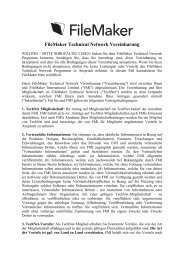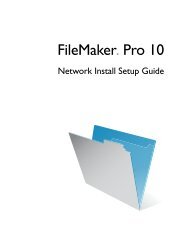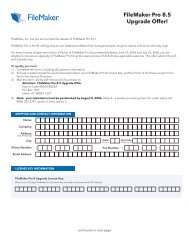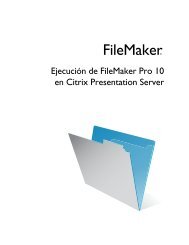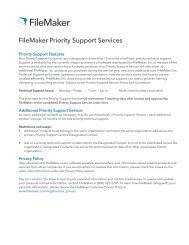FileMaker Security Guide
FileMaker Security Guide
FileMaker Security Guide
You also want an ePaper? Increase the reach of your titles
YUMPU automatically turns print PDFs into web optimized ePapers that Google loves.
Build security into your solutions 23<br />
• Review settings for remote access, such as file sharing and FTP, to ensure that direct access to<br />
upload or download files from the host computer are restricted in a manner that prevents<br />
inappropriate access to your files.<br />
• When you host a <strong>FileMaker</strong> Pro database using TCP/IP, you might be allowing uninvited visitors<br />
access to your host computer and internal network. A firewall is essential to separate your<br />
network and protect files “behind the firewall,” which prevents users on the outside of the<br />
firewall from accessing any TCP/IP addresses that you have not exposed.<br />
Web server security<br />
The web server application performs the critical task of processing and fulfilling requests for data<br />
when you publish databases, images, and other content on the web. When users enter a web address<br />
into their browser, they are requesting the web server software at that address to locate data or an<br />
image and download it to their computer, where it can be displayed in their browser. To protect the<br />
integrity of this process, your web server has its own security mechanism.<br />
If you host databases with <strong>FileMaker</strong> Server Advanced, use a third-party web server application<br />
such as Microsoft Internet Information Server (IIS) or Apache HTTP Server to publish files on the<br />
web. You can take advantage of additional security features, like SSL encryption, to transport data<br />
from the host to the web clients more securely.<br />
Use encryption or VPNs to protect data<br />
Consider using encryption and VPNs (Virtual Private Networks) to protect your databases on a<br />
TCP/IP network. Encryption is the process of manipulating data (clear text) such that the result<br />
(cipher text) can be understood only by certain applications.<br />
You can protect data by:<br />
• Setting up a secure VPN to encrypt some (or all) of your network traffic as it travels across a<br />
Wide Area Network (WAN).<br />
• Host databases with <strong>FileMaker</strong> Server Advanced and configure SSL encryption in the web<br />
server application.<br />
• Combining the above.<br />
Using Secure Sockets Layer (SSL) security for web publishing<br />
The SSL protocol is a standardized method for allowing encrypted and authenticated<br />
communication between web servers and clients (web browsers). SSL encryption is only available<br />
to databases hosted with <strong>FileMaker</strong> Server Advanced, and is enabled in the web server application,<br />
such as Microsoft Internet Information Server (IIS) or Apache HTTP Server by the Apache Group.<br />
SSL encryption converts information exchanged between servers and clients into unintelligible<br />
information through the use of mathematical formulas known as ciphers. These ciphers are then<br />
used to transform the information back into understandable data through encryption keys.<br />
For information on enabling and configuring SSL, review the documentation that accompanies your<br />
web server.



